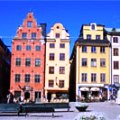
A (very brief) Guide to Stockholm
Stockholm, the largest city in Scandinavia, has a surprisingly large number of interesting sights, with plenty of palaces and monuments that are reminiscent of a time when the Swedish empire was one of Europe’s largest powers.
The city is defined by its location on a large archipelago, and it is spread over 14 islands. The abundance of water and the many riverboats have given Stockholm the name ‘Venice of the North’.
Predominant Architecture:
Stockholm has a history that dates back to the 13th century, possibly even longer. Most major buildings were mainly designed by influences from abroad. During 1600 and 1700, foreign architects were recruited to build the city and in recent periods Swedish architects often drew on their inspiration from their study tours to Europe, in the 20th century, particularly in the USA.
Stockholm’s historic buildings are largely conserved, possibly because the city escaped destruction by war, suffered by so many other cities in Europe.
Places to see:
Gamla Stan: The Old Town of Stockholm. The area, with its picturesque squares and cobblestone alleys is a favorite with visitors. Many of Stockholm’s top sights can be found here.
Royal Palace: Kungliga Slottet is a large Baroque palace built in the early 18th century at Gamla Stan. Every day during summertime crowds gather here to watch the Changing of the Guards.
Vasa Museum: The Vasa, a historic warship decorated with hundreds of statues, sank on its maiden voyage in 1628. It was salvaged in the mid 20th century and is now displayed in its own purpose-built museum.
Drottningholm Palace: The official residence of Sweden’s royal family. Built at the end of the 17th century in a Baroque style, it was one of the most magnificent palaces of its time.
Stadshuset: Stockholm’s city hall is one of Sweden’s most important 20th century buildings. It has a magnificent interior; its Golden Hall is decorated with gilded Byzantine mosaics.
Storkyrkan: The cathedral of Stockholm has a Gothic interior dating back to the 15th century. Inside is a unique wooden statue of St. George and the Dragon.
Strandvägen: Stockholm’s most impressive boulevard is lined with grand, monumental buildings that were designed during the 19th century by some of the best architects of the time.